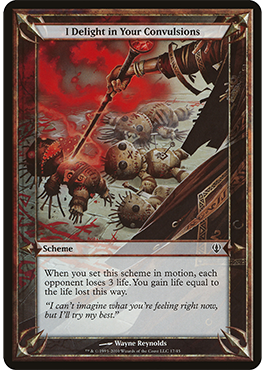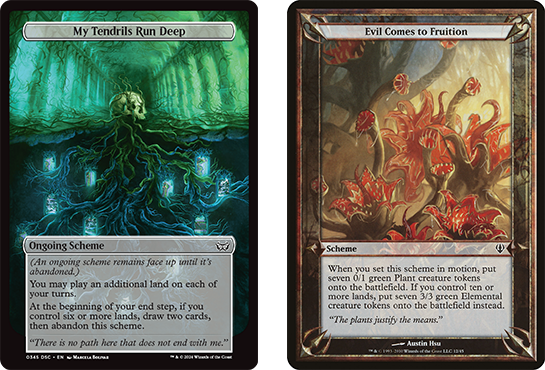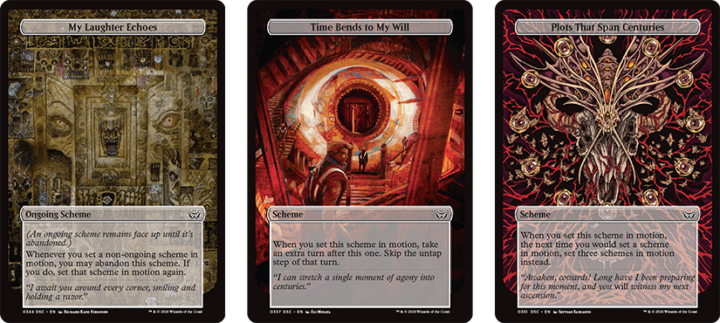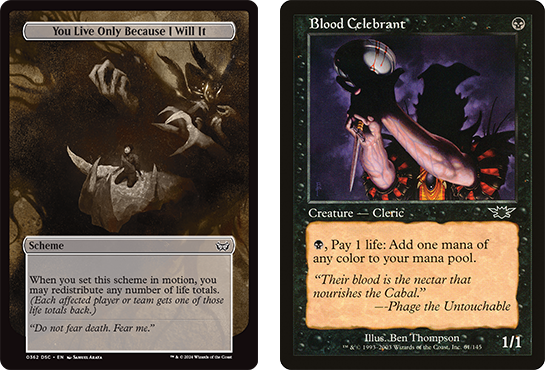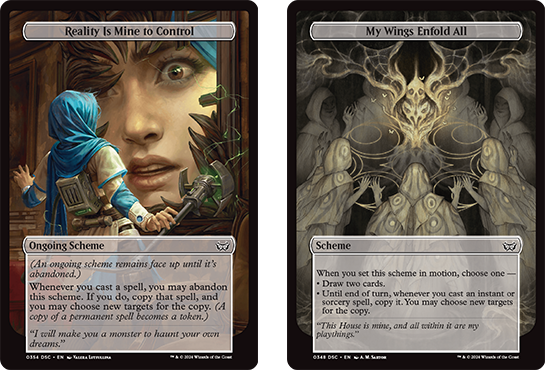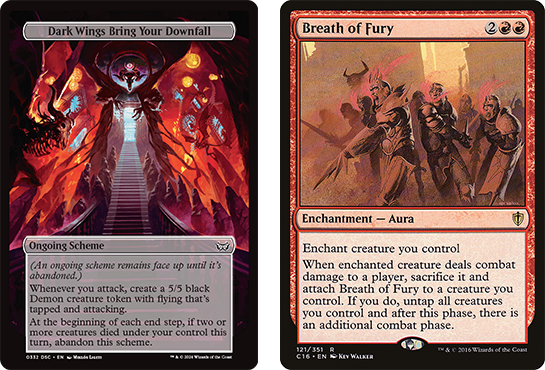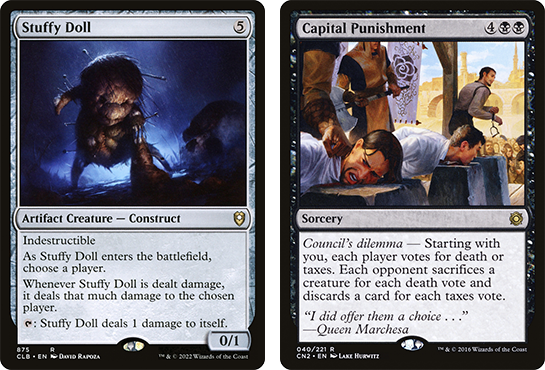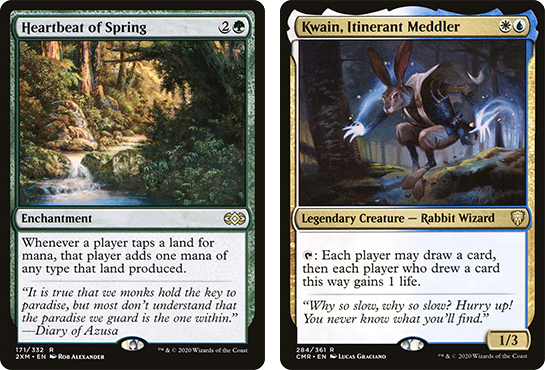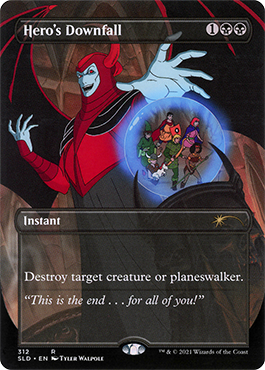The Commander precons for Duskmourn: House of Horror were always going to be an exciting prospect just for the powerful new cards and scary movie flavor. But Wizards had an extra–sneaky jump scare in store for us with these decks: a revival of the 1v3 Archenemy format!
Archenemy is one of the more exciting ideas Wizards has put together for a casual multiplayer format since the initial success of Commander itself. Rather than pit players against one another in cutthroat competition, three of them team up against one powerful nemesis – the titular arch-enemy. To offset the numbers disadvantage, that player benefits from a powerful “scheme deck”, containing unique villainous effects that trigger each turn to complement their usual spells.
While past products like Archenemy: Nicol Bolas may have been designed to emulate a specific storyline scenario, the cool part of Archenemy is that any deck – and now any Commander deck – can play the role of hero or villain. But how does playing with a team (or a Scheme) impact your deckbuilding decisions? And how can you set up a deck to most effectively embody the role of gloating mastermind?
MAY ALL YOUR SCHEMES COME TRUE
The most obvious starting point if you’re looking to tweak your Archenemy experience is the Scheme Deck. Just like choosing a commander or companion, which schemes you select will have an outsized impact on gameplay – and your deckbuilding, if you’re willing to craft a decklist specifically for playing the bad guy.
You need at least ten unique scheme cards to make a deck, which is the number provided in each of the Duskmourn precons. But if you consider the schemes printed across all previous Archenemy products gives us roughly 100 options (discarding a handful made ineffective by rules changes), so there’s a lot of potential for personalized evil!
For instance, certain schemes have an empowered “lategame” effect which unlocks once the archenemy player controls six or more lands. But most green Commander decks should be able to ramp up to six lands extremely quickly, which seeds the idea of a scheme deck focused entirely on those payoffs!
Fill the remaining slots with schemes which actually help you ramp, and your full deck could look something like this:
- You Exist Only to Amuse
- You Are Unworthy of Mercy
- Power Without Equal
- No Secret Is Hidden from Me
- Pay Tribute to Me
- Behold My Grandeur
- Evil Comes to Fruition
- My Tendrils Run Deep
- This World Belongs to Me
- Realms Befitting My Majesty
Decks which aim to storm off as their win con can piggyback off the schemes which cast free spells, as well as some powerful sources of free cards and mana:
- When Will You Learn
- No Secret Is Hidden From Me
- Power Without Equal
- My Wish Is Your Command
- I Am Duskmourn
- Mine Is the Only Truth
- My Wings Enfold All
- Because I Have Willed It
- Plots That Span Centuries
- My Wealth Will Bury You
Another popular effect among schemes is discard, and since they generally hit all opponents the potential yield for commanders like Nath, Tergrid or The Haunt of Hightower is extremely high! A scheme deck like this can also be used to cripple opponents in conjunction with draw-limiting effects like Notion Thief or Narset, Parter of Veils.
- Your Nightmares Are Delicious
- Every Hope Shall Vanish
- Every Dream a Nightmare
- Surrender Your Thoughts
- Only Blood Ends Your Nightmares
- Your Plans Mean Nothing
- Embrace My Diabolical Vision
- Time Bends to My Will
- Plots That Span Centuries
- My Laughter Echoes
Those last three schemes form a particularly useful little package for any archenemy who is trying to maximize the impact of specific scheme cards, since they each reroll or duplicate the other schemes in your deck.
THE HOUR OF MY TRIUMPH DRAWS NEAR
One of the nastiest ways to utilize schemes in Commander is as free combo pieces, allowing you to potentially stealing a sudden victory if one appears at the right time. Exactly which schemes work in this role will depend on what combos your maindeck is built to exploit, but some effects have more obvious potential than others.
You Live Only Because I Will It is an easy gamebreaker, albeit a risky one. Any effect which lets you pay flexible amounts of life (or otherwise damage yourself) can be used to lower your life to one, potentially in response to this scheme’s ability going on the stack. Since the updated Archenemy rules have all heroes sharing a single life total, any source of damage will then immediately finish them off Just make sure the red player is tapped out before you try this one!
Of course, if you’re deckbuilding to complement this scheme you can make things more secure with life-loss-doublers such as Bloodletter of Aclazotz – swapping an opponent to a lower life total doesn’t deal damage, but it does count as them losing life equal to the difference.
Reality Is Mine to Control and My Wings Enfold All can help you assemble a “copy target spell” loop. Normally you need to wait until there’s an instant or sorcery on the stack, target it with a copy effect like Reverberate, and then target that spell with another copy effect – but now a scheme can fill in for the second copy spell! Of course, to make this lethal you’ll need a triggered ability like Ral, Storm Conduit – which can itself be searched into play with Perhaps You’ve Met My Cohort…
Because I Have Willed It and The Pieces Are Coming Together apply static cost discounting effects which will unlock any number of possible infinite loops. Likewise, the mana-doubling effect on A Display of My Dark Power can lead to untap loops, usually with lands that are also artifacts or creatures. The draw-on-cast trigger of Mine is the Only Truth can help convert wins off spell loops with cards like Gravecrawler or Underworld Breach.
Other diabolical interactions include Dark Wings Bring Your Downfall plus Breath of Fury, I Am Never Alone in a Kiki-Jiki, Mirror Breaker deck, My Crushing Masterstroke plus sacrifice outlets, and Approach My Molten Realm with either my boy Heartless Hidetsugu or Malignus.
PLAYING THE NUMBERS GAME
Other than schemes, the most impactful rules change in Archenemy is simply that it’s played in teams. Not only does this change which cards and effects might be valuable to either side, but it allows for more specialized deckbuilding on the hero side as players might try to take up different roles to combat the multidimensional threat of the archenemy.
Looking at things from the hero side, the most obvious place to find value is in the cards which directly reference players sharing a team or otherwise co-operating. This includes the Assist keyword and other cards from the team-focused Battlebond set, spells with surge costs from Oath of the Gatewatch, the “join forces” cycle from Commander 2011, and Imperial Mask.
You can also look to leverage spells which implicitly allow cooperation between different players, such as Discerning Financier, the various curse-type auras, “voting” spells and similar effects like Council’s Judgment or Lavabrink Floodgates, and damage redirectors like Stuffy Doll or Brash Taunter.
Keep in mind though that your teammates do not count as “opponents” in this format, which invalidates some of the more abusive avenues for collusion. You cannot give your fellow heroes Wedding Rings, for example, nor can you have them set you up with favorable piles for effects like Fact or Fiction. For those new to the format, I should also make clear that while the heroes share a single life total, can block for each other and take their turns at the same time, that is the limit to the “sharing” among teammates. You cannot pay for one another’s spells, nor do you count as controlling or owning other heroes’ cards.
Beyond just leveraging multiplayer mechanics, effective teamwork can mean understanding the role your deck can fill and how you can best impact the archenemy. Since both your win and loss conditions are shared, it’s totally viable for one or more players to forgo advancing a game plan and play a pure “spoiler” role, particularly with counterspells or prison effects. The archenemy’s schemes are not spells, nor are they permanents – but they can be trumped using triggered ability counters like Stifle or Nimble Obstructionist.
Unlike in regular multiplayer, aggressively trading cards one-for-one can make a lot of sense for the heroes, since they only need to worry about locking down one opponent. They’re also incentivized to go deep on group hug effects that benefit all players – even if they do help the bad guy, you’re usually still getting 300% of the value they are.
By contrast, the archenemy is strongly incentivised to load up on sweepers, “each opponent” effects and other multi-target spells which can drain the hero side of significant resources per cast.
WAIT, WHY DO I HEAR BOSS MUSIC?
While getting your friends to all gang up on you might not sound like fun to all of you, I can promise that with the right decks and your trusty schemes by your side, playing as the archenemy is an absolute hoot. Reading out the melodramatic names of each scheme immediately puts you in the right mustache-twirling mood, and since the numbers advantage in Magic is very potent, you can feel justified in going all-out to tear down the heroes.
The rules change WotC made to the format with the release of these decks is crucial here – now that the heroes share a life total, the archenemy isn’t pushed into the unfortunate play pattern of focus-firing a single hero to take them out of the fight ASAP. This has also opened up a lot of the deckbuilding options we’ve just been discussing – especially for the heroes, who no longer need to worry about every one of their decks having the tools to potentially withstand that early-game onslaught!
The difficulty of balancing power level and matchups in a commander pod and the strategic biases of cutthroat multiplayer are two of the big sources of friction that lead to dissatisfaction in regular playgroups. If you’re feeling some of that fatigue, why not try out a few games of Archenemy as a potential antidote; one that will let you see familiar decks and cards in a new light.

Tom’s fate was sealed in 7th grade when his friend lent him a pile of commons to play Magic. He quickly picked up Boros and Orzhov decks in Ravnica block and has remained a staunch white magician ever since. A fan of all Constructed formats, he enjoys studying the history of the tournament meta. He specializes in midrange decks, especially Death & Taxes and Martyr Proc. One day, he swears he will win an MCQ with Evershrike. Ask him how at @AWanderingBard, or watch him stream Magic at twitch.tv/TheWanderingBard.



